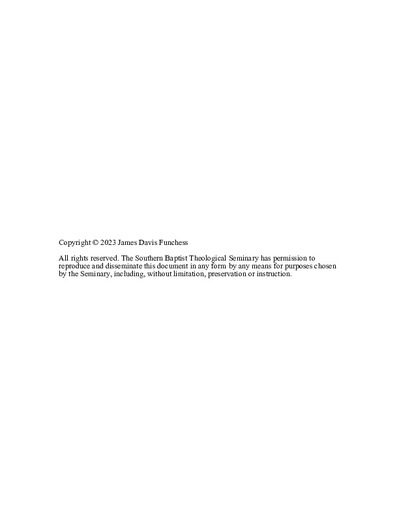| dc.description.abstract | In this dissertation, I argue that Thomas Manton’s categorical approach to sermon application, being thoroughly influenced by William Perkins and the Westminster Directory for Public Worship, maintained a teleological aim of transformation through an informed mind as conceptualized in the Augustinian tradition. Chapter 1 introduces the key components of this study and articulate the thesis of this work. Chapter 2 provides a biographical context for Thomas Manton. Chapter 3 explores the primary influences for Thomas Manton’s approach to application in the sermon. Throughout hundreds of sermon manuscripts, Manton employed categorical framework for sermon application. This categorical approach has its roots in the homiletical theory of William Perkins as laid out in his seminal work, The Arte of Prophesying, in which Perkins conceptualizes sermon application categorically, both in terms of hearers as well as actual application. Additionally, Manton was influenced by the Westminster Directory for Public Worship, written by the English Westminster divines. In the Directory, sermon application is again conceived in a categorical framework, specifically in terms of application categories. In chapter 4, I present a careful analysis of Manton’s extant sermon manuscripts with particular focus on application. I argue that Manton indeed followed the course charted by Perkins and Westminster, but also seek to show that Manton expanded on the available categories in his own sermons. In chapter 5, attention is shifted to the teleological aim of Manton’s categorical sermon application. I argue that Manton’s central focus in his sermon application was the transformation of those to whom he ministered. The catalyst for transformation in Manton’s theological framework was faith in Christ. A careful study of Manton’s Treatise of the Life of Faith provides the foundation for this chapter. The sixth chapter, following the discussion of Manton’s purpose in application, seeks to show how Manton’s understanding of human psychology affected the manner in which he applied the sermon to his hearers. Thomas Manton followed the prevailing psychological perspective of his day: faculty-humor psychology. Manton’s aim in sermon application was transformation through faith in Christ. This transformation, however, took place in the rational faculties of the soul: the mind, the will, and the affections. As such, Manton targeted the rational faculties of the soul in his sermon application and frequently mentioned the faculties by name in his sermons. In chapter 7, I conclude the study and provide final remarks on Manton’s works and their relation to the larger world of Puritan preaching. | en_US |

